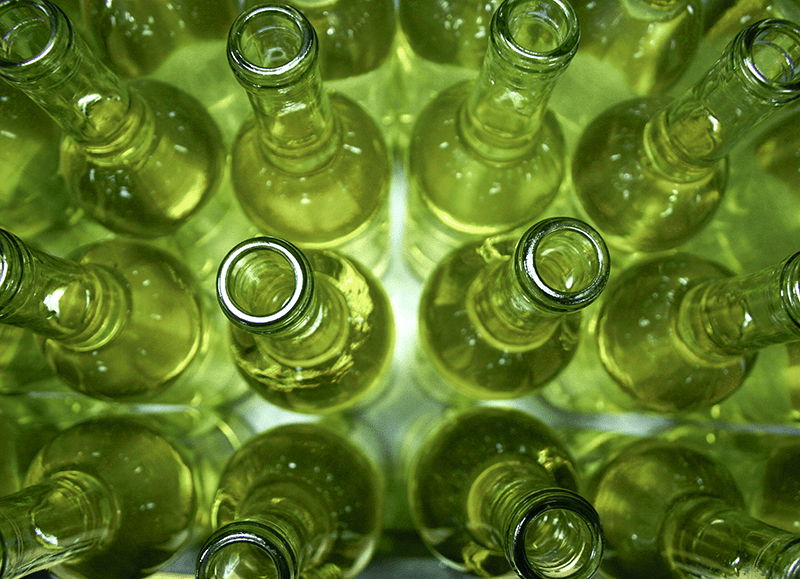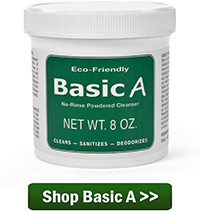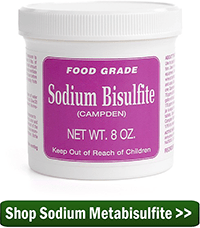 I am filling up my shopping cart with everything I need to start making wine in one large order. I see there are several products for sanitizing wine making equipment. What’ the best sanitizer for wine making? Can you explain how to sanitize the wine making equipment? Should certain cleaners and sanitizers be used for certain materials (glass vs plastic vs stainless steel)? Are there also different recommendations for wine types? I have read on some forums that Campden tablets can add sodium to the wine is should never be used, and others say there is no difference. What are your thoughts?
I am filling up my shopping cart with everything I need to start making wine in one large order. I see there are several products for sanitizing wine making equipment. What’ the best sanitizer for wine making? Can you explain how to sanitize the wine making equipment? Should certain cleaners and sanitizers be used for certain materials (glass vs plastic vs stainless steel)? Are there also different recommendations for wine types? I have read on some forums that Campden tablets can add sodium to the wine is should never be used, and others say there is no difference. What are your thoughts?
Joe – CO
—–
Hello Joe,
Thanks for your great questions about sanitizing wine making equipment. And, thanks for the order you are sending our way. It is truly appreciated!
Before you use any sanitizers, the wine making equipment should be soapy-clean. None of these sanitizers have any detergent quality to them that will help you with the grime. The wine making equipment needs to be visibly clean, first. Once you have your equipment soapy-clean then any of these sanitizers will work equally well. Any of them will be adequate for sanitizing wine making equipment to the level needed to keep your wines from spoiling.
With that being said, some are easier to use than others; some work better in certain situations than others. There are some debates as to which product is the best sanitizer for wine making. In general, I try to stick with sanitizers that don’t require any rinsing when sanitizing my wine making equipment. This is simply for the mere fact that they require less work.
The two sanitizers I personally like are Basic A and One-Step. Either of these are great for large surface areas such as fermenters. Neither require rinsing, and in fact, work better if you don’t rinse them. They are oxygenating cleansers, which means that they do their sanitizing as they air-dry on the surface of the wine making equipment. You just wet the surface and allow to air-dry.
Either of these sanitizers will work for smaller items such as air-locks and rubber stoppers, but for these types of items I prefer to use sodium metabisulfite. It works a little differently than an oxygenating cleanser in that when the sodium metabisulfite is mixed with water, the vapor that comes off of the solution is what does the actual sanitizing of the wine making equipment.
One simple thing I like to do is put a few inches of this solution in the bottom of a bucket fermenter; put in all my hoses, utensils, air-locks an anything else the will fit; and then seal it up air-tight for 30 or 40 minutes. Afterword, all you need to do is dump the solution out. No rinsing is necessary.
Sodium metabisulfite is also what I prefer to use for sanitizing wine bottles. All you need to do is put an inch of the solution in the bottom of each wine bottle for 30 minutes. Dump the solution out right before filling with the wine. No rinsing is necessary.
As for the using Campden tablets you mentioned, they could be used as well for sanitizing wine making equipment, but it is much easier to use sodium metabisulfite. They are essentially the same thing only the sodium metabisulfite is in powder form, not in tablets that need to be crushed up into a powder.
 You mentioned Campden tablets adding sodium to the wine. There is very little truth to this at all. Most Campden tablets are made from potassium metabisulfite, not sodium metabisulfite. From a sanitation standpoint they work the same way, only one leaves behind residual potassium, not sodium.
You mentioned Campden tablets adding sodium to the wine. There is very little truth to this at all. Most Campden tablets are made from potassium metabisulfite, not sodium metabisulfite. From a sanitation standpoint they work the same way, only one leaves behind residual potassium, not sodium.
When sodium metabisulfite is used as a sanitizer, the amount of sodium left behind is so small as to be undetectable. When sodium metabisulfite is added directly to the wine throughout the normal course of the wine making process, the amount of sodium added to the wine is less than one slice of pickle to 2 cases of wine – no way noticeable of or any significance.
Joe, I hope this answers your questions. Sanitizing wine making equipment is an important process. It’s shouldn’t be taken lightly or glossed over.
Happy Winemaking,
Ed Kraus
—–
Ed Kraus is a 3rd generation home brewer/winemaker and has been an owner of E. C. Kraus since 1999. He has been helping individuals make better wine and beer for over 25 years.

Thanks for the tutorial on sanitizing. My question is "does the k-meta need to dry completely before bottling?"
Everywhere I have read, including a class with a professional wine maker… cleansers are *not* sanitizers.
So how can you state that Basic A and One Step (two cleansers) could be used as sanitizers? That just seems plain wrong to me based on what I have been told.
You are correct, one step is a cleaner which they used to advertise as both a cleaner and a sanitizer. It should only be used as a cleaner. Then use an acid based sanitizer such as San star for a rinse.
Bill, any sulfite solution you use for sanitizing does not need to be rinsed or dried. Even if the surface is still wet, it is ready to be used.
Brad, this is mostly semantics. These cleansers destroy germs, mold, bacteria, etc. That’s what matters.
After I have sanitized my wine making supplies which I will use for transferring, bottling, etc., I use the sanitizing solution to clean my stainless steel coffee pot, my Stanley thermos, and all my stainless steel water bottles. Works like a charm and I get more then one use from the sanitizer.
I use kmeta with some citric acid and let it air dry
My concern is that too often the terms sanitize and sterilize are used interchangeably. Basic A and One Step are sanitizers. It is my understanding that they do not sterilize. Potassium metabisulfide and sodium metabisulfide are sterilizes. I sanitize first, and then sterilize. Comments please.
First time wine maker and complete sponge for great advice. Fantastic article. thanks for posting. Saved this to Evernote to reference repeatedly.
Is there a no-rinse sterilizer solution that can be stored so that I don’t need to make a new batch every time I stir the must? To sterilize the spoon?
First batch and LOVING it
FirstBatch, sulfite sanitizing solutions such as campden tablets will stay effective for at least 6 months if sealed airtight. There is no need to rinse of the sulfite solution.
After cleaning and sanitizing, is it time sensitive as to when you use it?
Ray, once you sanitize your equipment, you normally want to use it right away.